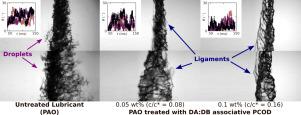当前位置:
X-MOL 学术
›
J. Non-Newtonian Fluid Mech.
›
论文详情
Our official English website, www.x-mol.net, welcomes your feedback! (Note: you will need to create a separate account there.)
Mist-control of polyalphaolefin (PAO) lubricants using long pairwise end-associative polymers
Journal of Non-Newtonian Fluid Mechanics ( IF 3.1 ) Pub Date : 2024-02-12 , DOI: 10.1016/j.jnnfm.2024.105197 Red C. Lhota , Robert W. Learsch , Jacob Temme , Vincent Coburn , Julia A. Kornfield
Journal of Non-Newtonian Fluid Mechanics ( IF 3.1 ) Pub Date : 2024-02-12 , DOI: 10.1016/j.jnnfm.2024.105197 Red C. Lhota , Robert W. Learsch , Jacob Temme , Vincent Coburn , Julia A. Kornfield

|
Accidental release of pressurized hydrocarbon fuels and lubricants are a major fire hazard due to the formation of small droplet mists that can readily evaporate and ignite. Mist control through increasing droplet size and suppressing droplets has been previously demonstrated with high molecular weight polymer additives, but traditional long polymer additives do not survive the pumping that would usually precede accidental release. This constraint inspired associative polymer additives that can transiently form the high molecular weights needed for mist control, while reversibly breaking during pumping. A prior study demonstrated the efficacy of such a system in fuel: long telechelic polycyclooctadiene (PCOD) with pairwise associating acid and base end-groups. Here, we address an obstacle to applying this same polymeric system in a polyalphaolefin (PAO) solvent—its poorer solvent quality for PCOD than fuel. We measured the effects of the end-associative PCOD compared to a non-associative control on the rheological properties of solutions in both PAO (a common lubricant and heat transfer fluid) and decahydronapthalene (decalin, a solvent with PCOD solubility similar to fuel) in shear and extension, and connect those rheological modifications to observed changes in PAO spray under simulated accidental release conditions. The PCOD additives demonstrated substantial mist control in PAO, both in terms of reduced spray angle and droplet suppression. Despite the worse solubility in PAO and thus smaller effective coil size, these associative PCOD additives are effective at the low concentrations (¡0.1 wt %) necessary for practical use as a safety measure.
中文翻译:

使用长成对末端缔合聚合物控制聚 α 烯烃 (PAO) 润滑剂的雾气
加压碳氢化合物燃料和润滑剂的意外释放是主要的火灾隐患,因为它们会形成容易蒸发和点燃的小液滴雾。之前已经通过高分子量聚合物添加剂证明了通过增加液滴尺寸和抑制液滴来控制雾气,但传统的长聚合物添加剂无法承受通常会在意外释放之前的泵送。这种限制激发了缔合聚合物添加剂的出现,这种添加剂可以瞬时形成雾控制所需的高分子量,同时在泵送过程中可逆地断裂。先前的一项研究证明了这种系统在燃料中的功效:具有成对缔合酸和碱端基的长遥爪聚环辛二烯(PCOD)。在这里,我们解决了在聚 α 烯烃 (PAO) 溶剂中应用相同聚合物体系的一个障碍,即 PCOD 的溶剂质量比燃料差。我们测量了末端缔合 PCOD 与非缔合控制相比对 PAO(一种常见的润滑剂和传热流体)和十氢化萘(十氢化萘,一种 PCOD 溶解度与燃料相似的溶剂)溶液流变特性的影响。剪切和拉伸,并将这些流变学改变与模拟意外释放条件下观察到的 PAO 喷雾变化联系起来。 PCOD 添加剂在 PAO 中表现出显着的雾气控制作用,无论是在减小喷雾角度还是在抑制液滴方面。尽管在 PAO 中的溶解度较差,因此有效线圈尺寸较小,但这些缔合 PCOD 添加剂在作为安全措施实际使用所需的低浓度 (±0.1 wt%) 下仍有效。
更新日期:2024-02-12
中文翻译:

使用长成对末端缔合聚合物控制聚 α 烯烃 (PAO) 润滑剂的雾气
加压碳氢化合物燃料和润滑剂的意外释放是主要的火灾隐患,因为它们会形成容易蒸发和点燃的小液滴雾。之前已经通过高分子量聚合物添加剂证明了通过增加液滴尺寸和抑制液滴来控制雾气,但传统的长聚合物添加剂无法承受通常会在意外释放之前的泵送。这种限制激发了缔合聚合物添加剂的出现,这种添加剂可以瞬时形成雾控制所需的高分子量,同时在泵送过程中可逆地断裂。先前的一项研究证明了这种系统在燃料中的功效:具有成对缔合酸和碱端基的长遥爪聚环辛二烯(PCOD)。在这里,我们解决了在聚 α 烯烃 (PAO) 溶剂中应用相同聚合物体系的一个障碍,即 PCOD 的溶剂质量比燃料差。我们测量了末端缔合 PCOD 与非缔合控制相比对 PAO(一种常见的润滑剂和传热流体)和十氢化萘(十氢化萘,一种 PCOD 溶解度与燃料相似的溶剂)溶液流变特性的影响。剪切和拉伸,并将这些流变学改变与模拟意外释放条件下观察到的 PAO 喷雾变化联系起来。 PCOD 添加剂在 PAO 中表现出显着的雾气控制作用,无论是在减小喷雾角度还是在抑制液滴方面。尽管在 PAO 中的溶解度较差,因此有效线圈尺寸较小,但这些缔合 PCOD 添加剂在作为安全措施实际使用所需的低浓度 (±0.1 wt%) 下仍有效。



























 京公网安备 11010802027423号
京公网安备 11010802027423号